Mecha Break review | Rock Paper Shotgun

In Mecha Break you play as a booby anime statuette. She is the one driving the mech. This is a leery game of lasers and ass shots, and sometimes even manages to elicit moments of exciting robo-a-robo combat. You fight other players across a splatter of multiplayer modes, and may often feel the crunch and weight and whirl of a Gundam-esque ground-to-sky battle of wits and bullets. But there is always a boob or two waiting for you after the heights of battle, jiggling over endlessly popping screens of free-to-play gubbins. Somewhere in Mecha Break is a good game, but you have to peel away the plastic tits and pushy sales screens to find it.
Let’s start where the game kicks off – character customisation. There’s barely any variety in body type or appearance, it is jiggle-physicsed hourglass girl or you quit the game. The only way I could create a vaguely different character was by applying my time-tested “one-up, one-down” rule to all the body meters. Eg. “arm length” gets blasted super high, then “arm width” goes super low, then “hand size” super high, and so on. Years of non-committal character customisation screens have taught me this is the fastest way to emerge from such menus with a bonafide monster.
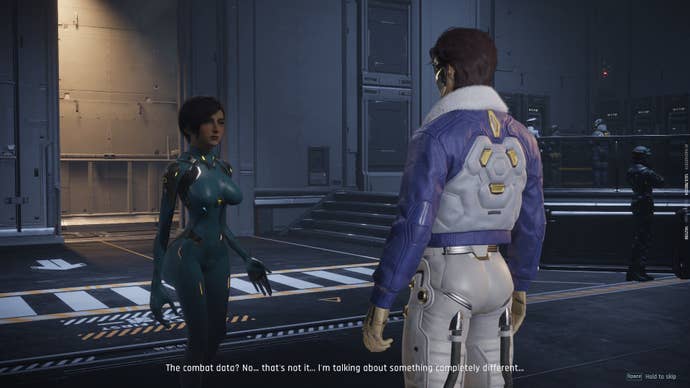
The tutorial runs you through the basic controls as part of a lore-establishing sequence of shockingly ropey dialogue and hackneyed storytelling that can barely keep a plot point straight. The world is infested with a mineral called “corite”, which is sentient, or it might be (no, it is) – wait, the jury is still out!
You get the hang of the controls quick enough, but the same tutorial does a poor job of teaching you the objectives of a real game, and doesn’t show you what any actual multiplayer match will look like. It’s like playing the opening act of a singleplayer game, complete with boss fights, then being dumped into the menus and told “lol, different game now”. You’ll need to play some matches for yourself to see what it’s actually about (or watch some of the briefing videos sequestered on another menu screen).
Or just listen to me. There’s a clutter of 6v6 game modes. There is plain deathmatch and a territory control mode, for example, with each mode getting its own dedicated maps. Another mode sees you trying to interrupt a number of spidery mining machines while the enemy team does likewise. Another has you grabbing and delivering little data gadgets to a central launch site. All the while boosting around and firing off volleys of ammo and special attacks at your online foes.
One of the better modes is an Overwatch-style escort job where you push a vehicle along a track, speeding it along by activating consoles en route. The enemy team has their own robotrolley on a parallel route and is racing you to the finish line, but you can reverse their payload by rudely standing on it. First to the end wins. If all this feels too crowded, there’s a 3v3 “ace arena” which is a more straightforward deathmatch – first to eight kills triumphs.
And then, ah, the obligatory extraction shooter mode. This sees you pummeling PvE minimechs, airships, turrets, and tanks on a much wider world map that is struck by periodic storms. You’re here to loot new toys for your mechalad, such as disposable rocket launchers or mods that can be attached to your robosuit. These mods will increase armour, or boost your rollerskatey speediness, but you’ll lose them if you die on the field.
Cue the the usual endlessly grasping loop of going into the warzone for stuff so you can go into the warzone for stuff so you can go into the warzone for stuff. Or, for me, a case of getting killed after 20-30 minutes, losing everything I gathered, and ignoring this mode forever out of a mixture of shame and annoyance. No, I have not liked an extraction shooter since The Division’s Dark Zone.
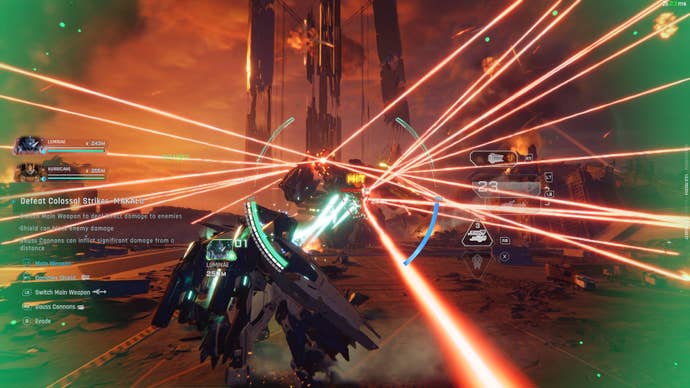
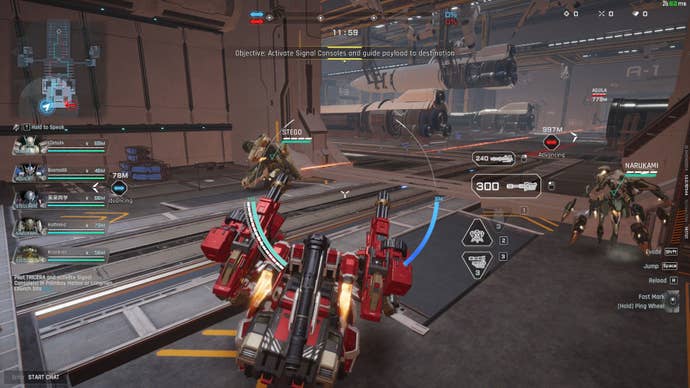
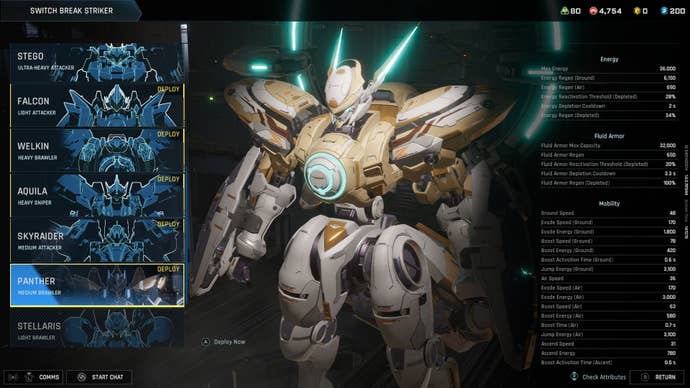
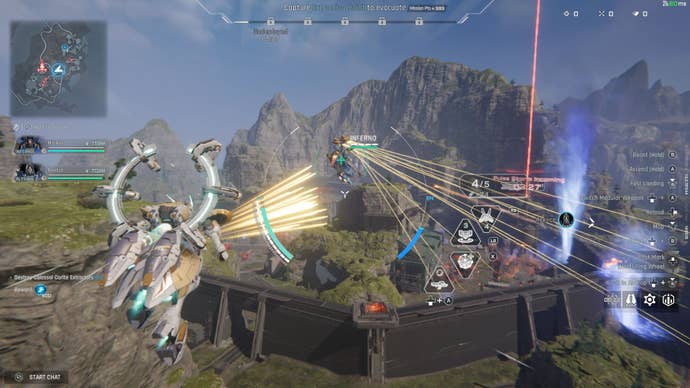
That there are so many modes to choose from feels in some ways old-fashioned. It reminds me of the years in which multiplayer modes were added to singleplayer games as an afterthought – pressured devs would just upend every idea they had into a bucket and hand in the whole thing. Yet here, in a free-to-play multiplayer-only game of the mid 2020s, it feels like the designers are just throwing every established multiplayer mode at the wall to see what sticks, like a mad Englishman trying to understand which of the nine types of pasta he has cooked are ready to eat.
I find the short, objective-focused fusilli goes down easier than the higher-stakes and ultimately slower-paced extraction spaghetti. The mechs, to be fair, handle like wondrous Gundam war machines, boosting freely all over the place at the touch of a button and rollerblading across the countryside with glowy-wheeled abandon. And there’s decent variety in the way they do battle.
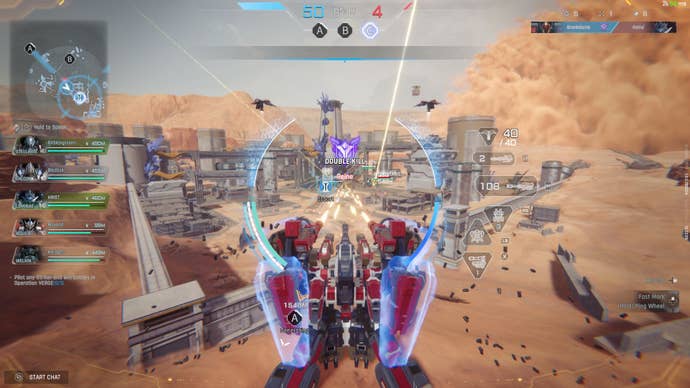
The slow Tricera has more miniguns than feels prudent and a hefty mortar cannon – it is my favourite mech. The Stego has a range of missile payloads and can become a fiery turret when it plants itself down on the spot. Narukami, a “light sniper”, can cloak themselves or spit out sneaky decoy holograms, while taking pot shots that do more damage the longer they charge.
There are support mechs who can plant down walls and repair damaged friends from afar. There’s a melee specialist with a pinning charge that brings to mind Reinhardt from Overwatch. And another hacky feller who can disrupt enemy targeting computers, making your foe’s normally blue teammates appear as flashing red enemies on-screen. Sadly, this hackerbot is only available after grinding out a bunch of tokens (more on the game’s hunger for cash in a moment).
The game does a piss-poor job of teaching you the specifics of each of these machines, however. The weapon descriptions are hidden away on extra tabs, in tiny writing and accompanied by reams of percentages which will mean nothing to anyone new to the game. There is a training mode, where you can test mechs, and only once you learn how to enter it and swap directly between mechs will things become much clearer. It sometimes feels like you are battling the game to understand its workings and intentions. It’s a hero shooter, essentially, but feels outright afraid to explain itself as one.
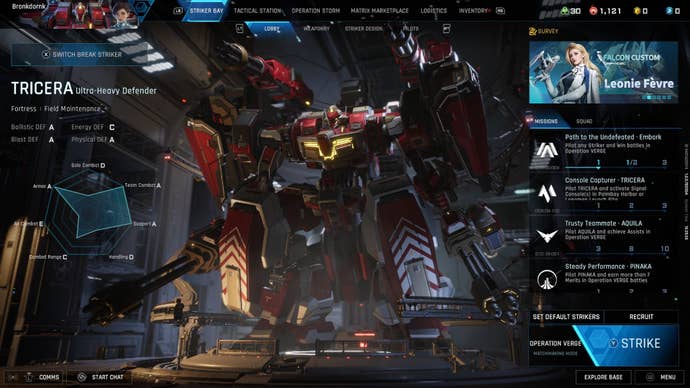
Initial confusion aside, there’s a good split between heftier fighters and lighter scrappers. The biglads have tanky armour and horrific ordinance, but they move slow and do some of their most damaging attacks when completely rooted to the ground. The nippier folks can turn into manoeuvrable jets or vanish from sight completely, but they are more fragile when it comes to their armour. A good team can conceivably work together, with flighty lighties coaxing enemies into range of heavier brutes, while themselves dipping behind their co-brawler’s shield bubbles and tanky armour plating.
This is the high-level dream of co-operative play, and I briefly felt it in one extraction game where I played the repairing support mech, keeping my battlebros healed from the back lines. I especially enjoyed seeing my highlights from this match – a reel of recorded footage that plays at the end of every game. This was the exception though. Most other battles felt more like chaotic bar room brawls. Even if they were often exciting in their own way, it rarely felt like a team sport. One or two people would play the objective. Everyone else goes for plain kills.
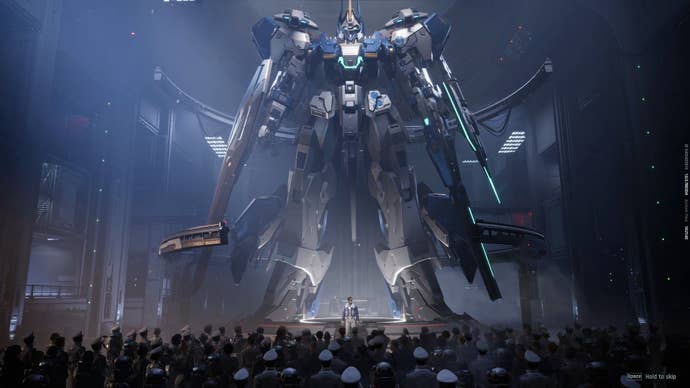
If duking it out as nippy mechfolk were all there was to Mecha Break, I’d have an easier time recommending it. But much of the game resides not on the field but in the menus, a bleepy-bloopy mess of sci-fi blueness, with all the expected free-to-play potpourri clogging up multiple screens with myriad currencies and special offers. Some of these feel like standard practice in the free-to-play world. For example, a few of the mechs, like Inferno (who has two giant laser shotguns that can be charged up for a twinblast of direct megapain) can only be obtained by grinding out tokens or buying them. That feels normal to me, as someone who got used to saving up for Apex Legends characters.
But a remarkable amount of simple things cost money. Want to play as a male pilot? That’ll be seven quid. Want to unlock a new outfit for your fearfully long-fingered sex doll? That’ll be a tenner. Players who enjoyed the beta are miffed that customisation options which once appeared to be free have since been taken away or locked behind a paywall. Even corite, that sinister fictional mineral which infests the world as a corrosive environmental hazard, also happens to be a currency you buy with real money in batches of 500 or 1000. The logic of this fictional futureworld grows ever more inexplicable.

Even if you’re trying your best to avoid this stuff, animated flash after animated flash assaults you as you navigate around the cluttered, confusing menus. You’ve earned 500 mission tokens! (What are those?) You’ve unlocked a beret! (Okay but how?) You’ve progressed up this bar of indecipherable icons! (Please stop interrupting me while I paint my mech an expensive shade of red.) End-of-mission reports are an assault on your eyes with whizzes and cracks of reward screens, as if the very lights of neo-Las Vegas are being beamed into your retinas.
It isn’t a gacha game as such, but it mirrors the gacha game’s tactics of overwhelm and numbersprinkling, an attack on attentional dignity that you will immediately recognise as a symptom of extractive game design. It doesn’t feel “pay-to-win”, contrary to the common fear about such games (I’m landing plenty of kills as a freeloader) but it does sour every minute outside of the actual matches. Immediately after the tutorial you are advertised a pilot with a cooler designed mech for the low low price of £47.99. I urge you: go buy an entire other game instead.
In some sense judging Mecha Break for these free-to-play foibles is a pity. Because buried beneath the weedlike mass of microtransactions, the noise of lootboxes opening, the lecherous lingering over chests and butts, and the legion of screens popping up to flummox you with unintelligible currencies, there is a slight but glowing core: a decent multiplayer action game with a lot of admittedly cool robots. It is a shame this core is housed in the greebly shell of a desperate salesbot, hawking at you every step of the way. Mecha Break upsells to you even as you leave – quit the game, and there is an advert to follow it on social media. Mate, I can barely follow what you said in the briefing room.












